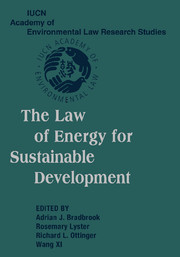Book contents
- Frontmatter
- Contents
- Acknowledgments
- Message from Kofi A. Annan, Secretary-General, United Nations
- Introduction – A Global Learned Society to Address Earth's Evolution: The IUCN Academy of Environmental Law
- Public Lectures on International Environmental Law
- PART ONE SUSTAINABLE DEVELOPMENT AND THE ROLE OF ENERGY LAW
- PART TWO LEGAL ISSUES IN CONTEMPORARY ENERGY LAW
- PART THREE INTERNATIONAL ENERGY LAW
- 11 International Law and Global Sustainable Energy Production and Consumption
- 12 Policy Options
- 13 Financing Energy for Sustainable Development
- 14 The Clean Development Mechanism and UNFCCC / Kyoto Protocol Developments
- 15 The Report of the World Commission on Dams: Some Implications for Energy Law
- 16 International Issues for Sustainable Development: IUCN Perspective
- 17 Enhanced Implementation and Enforcement of International Environmental Laws by the Judiciary
- PART FOUR COMPARATIVE ENERGY LAW
- PART FIVE ELECTRICITY RESTRUCTURING
- PART SIX FINANCING FOR SUSTAINABLE ENERGY
- PART SEVEN CIVIL SOCIETY AND THE PROCEDURAL REQUIREMENTS OF ENERGY LAW FOR SUSTAINABLE DEVELOPMENT
- Index
16 - International Issues for Sustainable Development: IUCN Perspective
Published online by Cambridge University Press: 10 August 2009
- Frontmatter
- Contents
- Acknowledgments
- Message from Kofi A. Annan, Secretary-General, United Nations
- Introduction – A Global Learned Society to Address Earth's Evolution: The IUCN Academy of Environmental Law
- Public Lectures on International Environmental Law
- PART ONE SUSTAINABLE DEVELOPMENT AND THE ROLE OF ENERGY LAW
- PART TWO LEGAL ISSUES IN CONTEMPORARY ENERGY LAW
- PART THREE INTERNATIONAL ENERGY LAW
- 11 International Law and Global Sustainable Energy Production and Consumption
- 12 Policy Options
- 13 Financing Energy for Sustainable Development
- 14 The Clean Development Mechanism and UNFCCC / Kyoto Protocol Developments
- 15 The Report of the World Commission on Dams: Some Implications for Energy Law
- 16 International Issues for Sustainable Development: IUCN Perspective
- 17 Enhanced Implementation and Enforcement of International Environmental Laws by the Judiciary
- PART FOUR COMPARATIVE ENERGY LAW
- PART FIVE ELECTRICITY RESTRUCTURING
- PART SIX FINANCING FOR SUSTAINABLE ENERGY
- PART SEVEN CIVIL SOCIETY AND THE PROCEDURAL REQUIREMENTS OF ENERGY LAW FOR SUSTAINABLE DEVELOPMENT
- Index
Summary
IUCN – THE WORLD CONSERVATION UNION: A UNIQUE GLOBAL PARTNERSHIP
The perspectives of IUCN – The World Conservation Union on energy for sustainable development relate directly to what the institution is and stands for.
IUCN is a unique global partnership established in 1948 in Fontainebleau, France. It is a membership based organization, which today has close to 1,000 members, including states, government agencies, and nongovernment members.
There are several components of IUCN, all of which play complementary roles. The highest organ of IUCN is the World Conservation Congress, which is where all IUCN members meet and set IUCN's “general policy,” and approve the program and financial plan for the Union. At the Congress the membership also elects its office holders, including the President, members of Council, and Commission Chairs. The other components of IUCN are the Council, National and Regional Committees of Members, Commissions, and the Secretariat.
IUCN was granted United Nations Observer status in 2000, and is the only conservation organization in the world to enjoy such status. IUCN is also recognized as an intergovernmental organization with most convention secretariats it works with and the UNEP Governing Council.
IUCN's vision is: “a just world that values and conserves nature” and its mission is to: “influence, encourage and assist societies throughout the world to conserve the integrity and diversity of nature and to ensure that any use of natural resources is equitable and ecologically sustainable” [emphasis added].
- Type
- Chapter
- Information
- The Law of Energy for Sustainable Development , pp. 255 - 259Publisher: Cambridge University PressPrint publication year: 2005



